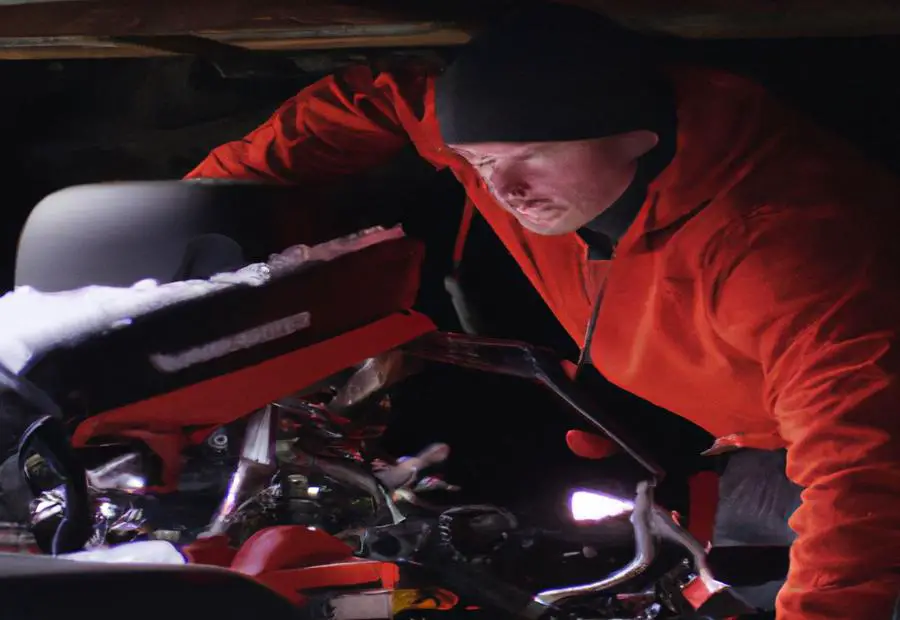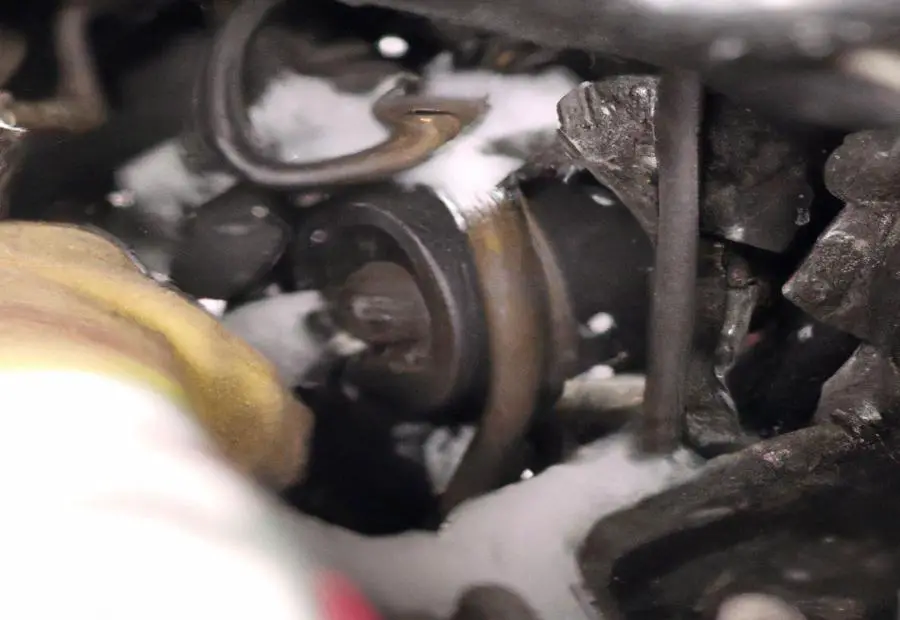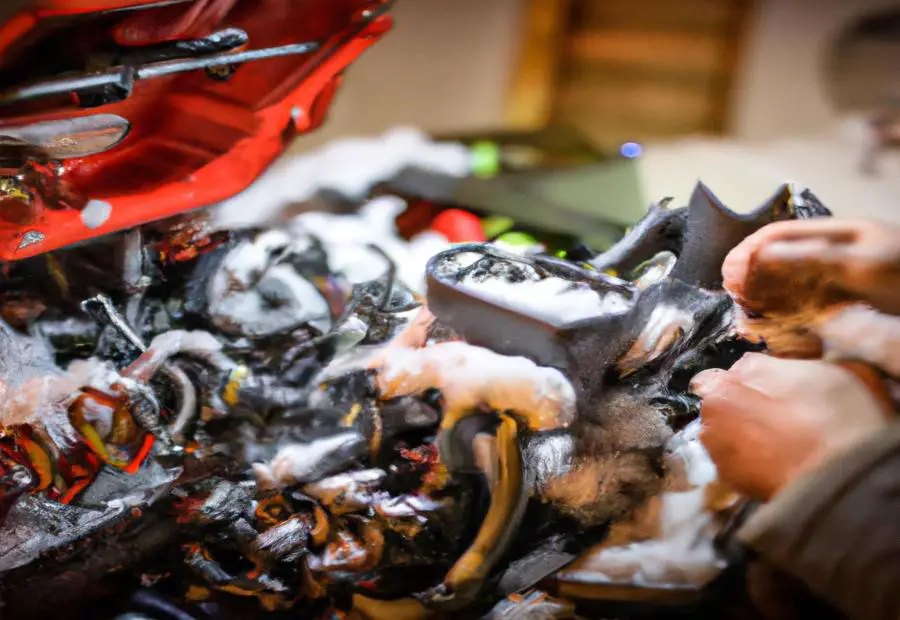GardenerHeaven.com is reader-supported. When you buy through links on our site, we may earn an affiliate commission.
.jpg)

Photo Credits: Gardenerheaven.Com by Jesse Gonzalez
When it comes to troubleshooting and fixing a snowblower that’s running rough, understanding the common problems is key. In this section, we’ll provide an overview of the issues frequently encountered with gas snowblowers. From clogged fuel lines to spark plug problems, we’ll explore the potential culprits behind your snowblower’s performance issues. Get ready to tackle these challenges head-on and get your snowblower running smoothly again.
Overview of common problems with gas snowblowers
Gas snowblowers can have various issues that can impact their performance. Such problems include:
- Fuel delivery: Fuel does not reach the engine correctly. Checking and adjusting the fuel delivery system is vital for smooth operation.
- Carburetor blockages: Dirt and debris build-up can lead to a decrease in efficiency. Regular inspection and cleaning of the carburetor can help avoid this problem.
- Dirty air filters: They can reduce engine performance, so it’s important to check and replace them often.
- Lack of lubrication in moving parts: This can cause them to become stiff or damaged. Lubricating and cleaning these parts will keep them working.
- Misaligned valve lash: It can affect engine performance. Adjusting the valve lash optimizes engine performance.
- Engine oil issues: Regular oil changes and inspecting the engine sump gasket for wear or damage are important.
- Ignition system malfunctions: Checking the ignition system and spark plug are crucial.
- Low compression: It can affect performance and may require professional assistance.
A Vermont couple experienced difficulties with their gas snowblower during winter storms, even though they followed maintenance instructions. They found out a fuel delivery problem caused inconsistent performance. By making changes and cleaning the fuel delivery system, they were able to restore their snowblower’s efficiency and deal with the snow. This shows how important it is to troubleshoot common issues to keep gas snowblowers in top condition.
To keep your gas snowblower running smoothly, follow these simple tune-up steps:
Snowblower Tune-up: Steps to Solve Gas Snowblower Problems

Photo Credits: Gardenerheaven.Com by Ronald Nguyen
When it comes to keeping your gas snowblower running smoothly, a proper tune-up can make all the difference. In this section, we will walk you through the essential steps to troubleshoot and fix common gas snowblower problems. From checking and adjusting fuel delivery to inspecting and cleaning the carburetor, we’ll cover all the necessary tasks to ensure your snowblower performs at its best when the winter weather hits.
Checking and adjusting fuel delivery
Fuel delivery is a must for gas snowblowers. To make sure it runs smooth, regular check and adjustments are needed. Here’s how:
- Check Fuel Lines: Look for any damage or blockage. Make sure the lines are securely connected and leak-free.
- Adjust Fuel Mixture: Turn the adjustment screws on the carburetor to get optimal performance. Follow the manufacturer’s guidelines.
- Clean or Replace Fuel Filter: A dirty filter can block fuel flow and cause problems. Regularly clean or replace it.
- Test Fuel Flow: Start the snowblower and check for interruptions. Sputtering or stalling is an indication that something’s wrong.
Remember to consider your model’s specifics and call a professional if you get stuck. Proper maintenance will increase snowblower life and performance every winter. So get your carburetor ready and enjoy a purring snowblower!
Inspecting and cleaning the carburetor
For smooth operation of your gas snowblower, inspect and clean the carburetor regularly. Debris & varnish can build up, leading to engine performance issues. Here’s a 5-step guide to help:
- Uncover the air filter and take out the filter assembly. Now you can access the carburetor.
- Detach the fuel line from the carburetor, with a container ready to catch any spilt fuel.
- Get a small brush or toothbrush to remove dirt & debris from the carburetor’s exterior and interior. Pay attention to the small openings & passages.
- Check the gaskets & seals for signs of wear or damage. Replace if needed.
- Reattach the fuel line and put back the air filter assembly.
Remember: Each snowblower has specific requirements for inspecting & cleaning its carburetor. Refer to the user manual or get professional assistance.
Pro Tip: Use carburetor cleaner spray to remove built-up deposits without harming the sensitive components.
Finally, check & replace the air filter often for your snowblower to breathe easy.
Checking and replacing the air filter
The air filter of a gas snowblower is crucial. It needs constant checking and replacing. Neglect it, and you get poor engine performance and decreased efficiency.
To make sure your gas snowblower runs well, follow these four steps to check and replace the air filter:
- Look for a rectangular or cylindrical box, attached to the carburetor or engine. It’s usually held by screws or clips.
- Use a screwdriver or pliers to take out any clips or screws. Gently lift off the cover to get to the filter.
- Check the filter for dirt, dust, or foreign particles. If it’s too clogged or dirty, replace it.
- If the filter is disposable, get a new one of similar size and shape. If it’s reusable, tap it on a soft surface or use compressed air to blow out the dirt.
Refer to your snowblower’s manual for more details. Inspecting and maintaining the air filtration system helps get optimal snow clearing.
Remember, a dirty or clogged air filter decreases engine power and causes disruption. So, cleaning or replacing it regularly is essential for long-lasting performance.
Here’s something interesting: 9 out of 10 cases of rough running or poor performance can be attributed to simple maintenance issues like a dirty air filter. (Source: ‘Snowblower Running Rough? Learn How to Troubleshoot and Fix It!’).
Lubricating and cleaning moving parts
To keep your gas snowblower running smooth, regular maintenance is key. Neglecting this crucial step can result in increased friction between components, leading to faster wear and potential breakdown. Follow these simple steps for optimal results.
- Start by disconnecting the spark plug wire to avoid accidental engine starting.
- Then, locate the moving parts that need lubrication, like pivot points, auger shafts, and impeller bearings.
- Use a high-quality lubricant designed for outdoor power equipment.
- Apply a small amount of lube to all parts using a brush or rag. Be thorough to make sure all areas are coated.
- Lastly, use a cloth or brush to remove any dirt, debris, or old lube from the surfaces.
Inspect all moving parts for signs of wear or damage. If you notice any, replace the worn-out components to maintain optimal performance. Doing this regularly and addressing any problems in time can save you from costly repairs.
Regularly clean and lubricate the moving parts of your gas snowblower. Don’t wait until it starts acting up before taking care of them. This will extend the lifespan of your snowblower and keep it working efficiently for years.
Adjusting valve lash
- Disconnect the spark plug wire to avoid accidental engine start.
- Remove the valve cover to access valves and tappets.
- Turn the engine manually until you reach top dead center on the compression stroke of the chosen cylinder.
- Check the gap between valve stem and tappet with a feeler gauge. Adjust by loosening or tightening the locknut and turning the adjusting screw.
- Re-measure the gap with a feeler gauge to make sure it meets manufacturer specifications.
- Repeat the process for all valves in the engine of your gas snowblower.
Remember to follow manufacturer guidelines for specific measurements and adjustments when adjusting valve lash. This is essential to avoid engine damage or poor performance. Doing regular checks and adjustments will help maintain your gas snowblower’s performance and durability.
By properly adjusting valve lash, you can maximize engine performance and prevent issues due to clearance between valves and tappets. Regular checks and adjustments will keep your gas snowblower in top condition.
Changing oil and inspecting the engine sump gasket
Changing the oil is key to keeping a gas snowblower running well. Lubrication and a secure engine sump gasket are vital for smooth operation.
Here are the steps to change the oil in a gas snowblower:
- Locate the engine’s oil drain plug.
- Unscrew and take out the plug, pouring the old oil into a container. Then, discard the oil properly.
- Replace the plug and open the oil filler cap or dipstick.
- Add in fresh oil as instructed by the manufacturer. Use a funnel to avoid spills.
- Inspect the engine sump gasket, clearing away any debris or dirt with a clean cloth or brush.
- Look for any cracks, tears, or other damage that could weaken the gasket. If any issues are spotted, consult the snowblower’s manual or contact a professional.
Remember to safely dispose of used oil and follow local regulations. By changing oil and examining the sump gasket, you can help keep your snowblower running optimally and extend its life.
Checking the ignition system and spark plug
To check your gas snowblower’s ignition system and spark plug correctly, here’s what you should do:
- Examine the spark plug: Remove it from the engine and look for signs of wear or damage. Clean or replace it if needed.
- Test for spark: Connect the spark plug to the ignition wire. Ground the threaded part on the engine block, then pull the starter cord. Check for a strong blue spark between the electrode and grounding point.
- Check ignition timing: Use a timing light. If it’s not set properly, refer to the snowblower’s manual for instructions on how to adjust it.
- Inspect wiring connections: Check all wiring connections associated with the ignition system. Look for loose or damaged wires. Make sure connections are snug and replace any faulty ones.
- Test the ignition switch: Make sure it activates and deactivates the ignition system correctly when turned on and off.
Follow these steps to keep your snowblower running reliably. Also, don’t forget other key maintenance tasks like inspecting fuel delivery, cleaning the carburetor, replacing the air filter, lubricating and cleaning moving parts, adjusting valve lash, changing oil, and inspecting the engine sump gasket, as well as testing the battery and compression.
Pro Tip: Regularly checking and cleaning your snowblower’s ignition system and spark plug can help you avoid starting issues and get optimum performance when clearing snow.
Testing the battery and checking for low compression
Testing the battery and checking for low compression? Follow this four-step guide!
- Assess the battery’s condition. Measure voltage with a voltmeter. 12 volts is fully charged. Lower readings may indicate needing to recharge or replace.
- Check for low compression. Remove spark plug from one cylinder, and put in a compression gauge. Pull starter rope several times and view the gauge. 90-120 psi is healthy.
- If readings are within normal parameters, keep troubleshooting.
- If readings are not normal, take appropriate action, like recharging or replacing battery, or getting professional help.
Note that these are just two steps in tuning up gas snowblowers. Other steps include inspecting fuel delivery, cleaning carburetors, replacing air filters, lubricating parts, adjusting valve lash, changing oil, inspecting engine sump gaskets, checking ignition systems and spark plugs.
Perform these steps to improve performance and reliability of your snowblower!
Conclusion

Photo Credits: Gardenerheaven.Com by Robert Anderson
Starting a snowblower engine can be tricky–especially if it’s running rough. But, by following a few troubleshooting steps, you can fix the issue and make it run smoothly.
- A clogged fuel system is a common reason for rough-running. Cleaning the carburetor and fuel lines will help fuel move to the engine.
- Checking and replacing the spark plug can also help.
- A dirty air filter can stop air flow and affect the engine’s combustion. Cleaning or replacing the air filter regularly can help the engine work well.
- Lastly, check for any loose or damaged parts like the fuel cap and spark plug wire.
By following these steps, you can fix a rough-running snowblower. Properly maintaining and addressing snowblower components will reduce chances of engine issues.
Some Facts About Snowblower Running Rough and How to Fix It:
- ✅ The most common cause of a gas snowblower running rough is a problem with the carburetor. (Source: Team Research, Sears Parts Direct)
- ✅ Another possible cause is a clogged fuel filter, which can prevent the engine from receiving fuel. (Source: Team Research, Sears Parts Direct)
- ✅ A dirty spark plug can also cause a rough-running engine by inconsistent ignition of the fuel. (Source: Team Research, Sears Parts Direct)
- ✅ Incorrect valve lash can lead to a rough-running engine and should be checked and adjusted regularly. (Source: Team Research, Sears Parts Direct)
- ✅ A leaking engine sump gasket can cause low compression and rough running, requiring replacement. (Source: Team Research, Sears Parts Direct)
FAQs about Snowblower Running Rough? Learn How To Troubleshoot And Fix It!
Question 1: Why is my gas snowblower engine running rough?
Answer 1: Gas snowblower engines can run rough due to several factors. Common causes include issues with the carburetor, clogged fuel filter, dirty spark plug, incorrect valve lash, or a leaking engine sump gasket.
Question 2: How can I fix a gas snowblower engine that runs rough?
Answer 2: To fix a rough running gas snowblower engine, you can start by conducting a snowblower tune-up. This involves changing the oil, cleaning the engine, replacing the air filter, inspecting the carburetor, checking the ignition system, testing the battery, adjusting the throttle and choke controls, and lubricating all moving parts. Additionally, you may need to replace the spark plug, clean and rebuild the carburetor, adjust the valve lash, and replace the fuel filter if necessary.
Question 3: What should I do if my gas snowblower engine has a dirty spark plug?
Answer 3: If your gas snowblower engine has a dirty spark plug, it can cause rough running. To resolve this issue, you should check the spark plug and replace it if needed. Make sure to set the gap correctly and follow three quick steps for a proper installation.
Question 4: How often should I adjust the valve lash on my gas snowblower engine?
Answer 4: It is recommended to check and adjust the valve lash on your gas snowblower engine every 100 hours of operation. Incorrect valve lash can lead to a rough running engine or prevent it from starting properly. Regular valve lash adjustments are essential for peak operating condition.
Question 5: Is it necessary to clean and rebuild the carburetor of my gas snowblower?
Answer 5: Yes, cleaning and rebuilding the carburetor of your gas snowblower is important, especially if you’re experiencing fuel supply problems. You can use rebuild kits available for most carburetors. Disassembling and cleaning the carburetor, followed by a rebuild using the kit, can help fix fuel delivery issues and ensure smooth engine operation.
Question 6: Why should I replace a clogged fuel filter in my gas snowblower?
Answer 6: A clogged or damaged fuel filter in a gas snowblower can prevent fuel from reaching the carburetor, causing rough engine running. To resolve this issue, it is necessary to replace the clogged fuel filter. Proper fuel flow is crucial for the engine’s performance, and a new fuel filter will ensure smooth operations.



